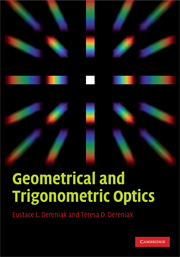Book contents
- Frontmatter
- Contents
- Preface
- 1 Light propagation
- 2 Reflections and refractions at optical surfaces
- 3 Image formation
- 4 Mirrors and prisms
- 5 Curved optical surfaces
- 6 Thin lenses
- 7 Thick lenses
- 8 Mirrors
- 9 Optical apertures
- 10 Paraxial ray tracing
- 11 Aberrations in optical systems
- 12 Real ray tracing
- Appendix A Linear prism dispersion design
- Appendix B Linear mixing model
- Appendix C Nature's optical phenomena
- Appendix D Nomenclature for equations
- Appendix E Fundamental physical constants and trigonometric identities
- Glossary
- Index
- References
2 - Reflections and refractions at optical surfaces
Published online by Cambridge University Press: 06 July 2010
- Frontmatter
- Contents
- Preface
- 1 Light propagation
- 2 Reflections and refractions at optical surfaces
- 3 Image formation
- 4 Mirrors and prisms
- 5 Curved optical surfaces
- 6 Thin lenses
- 7 Thick lenses
- 8 Mirrors
- 9 Optical apertures
- 10 Paraxial ray tracing
- 11 Aberrations in optical systems
- 12 Real ray tracing
- Appendix A Linear prism dispersion design
- Appendix B Linear mixing model
- Appendix C Nature's optical phenomena
- Appendix D Nomenclature for equations
- Appendix E Fundamental physical constants and trigonometric identities
- Glossary
- Index
- References
Summary
Rays
In geometrical optics, light is assumed to travel in a definite direction from a source, exhibiting a behavior known as rectilinear propagation. One useful way to think of light is to imagine it traveling in a very narrow beam, which is to say that light can be modeled as a ray. The emergent ray can be thought of as being a very narrow line. A ray of light is like a mathematically infinite thin line, but a light ray has direction while a line does not. The rays of geometrical optics are perpendicular to the wavefronts, and indicate the most probable path of the photons of quantum optics. A wavefront is an undulation of energy which propagates from one point to another and, as it travels, it carries electromagnetic energy. The wavefront is conceptualized as a surface with a fixed phase across it, and periodic oscillations (sinusoid) in the direction of propagation, with each wavefront having its own wavelength, frequency, amplitude, phase, and polarization.
The point source in Figure 2.1 illustrates the relationship between wavefronts and rays. The source emits energy in a spherical shell in all directions (4π sr), propagating at the speed of light. A wavefront is the locus of points on rays that have the same optical path length from the point source (same number of periods). The wavefront is perpendicular to the rays. At an infinite distance, the spherical wavefront turns into a plane wavefront (at that point the radius equals infinity).
- Type
- Chapter
- Information
- Geometrical and Trigonometric Optics , pp. 30 - 48Publisher: Cambridge University PressPrint publication year: 2008



